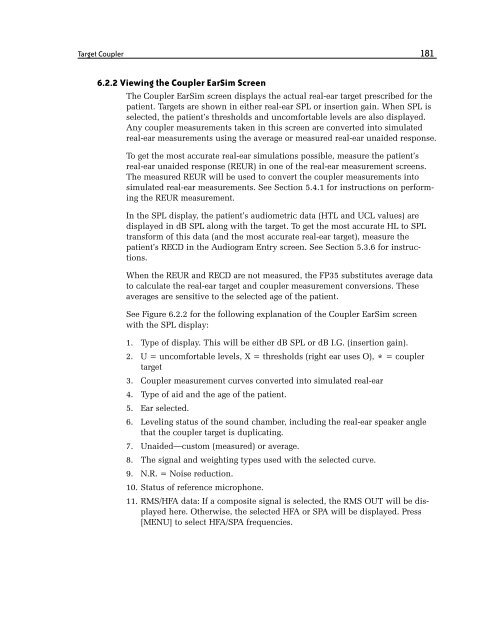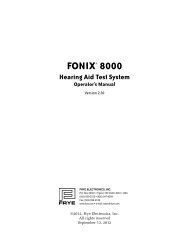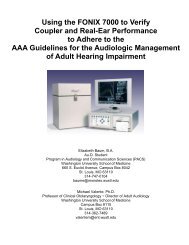FONIX® FP35 Touch - Frye Electronics
FONIX® FP35 Touch - Frye Electronics
FONIX® FP35 Touch - Frye Electronics
You also want an ePaper? Increase the reach of your titles
YUMPU automatically turns print PDFs into web optimized ePapers that Google loves.
Target Coupler 181<br />
6.2.2 Viewing the Coupler EarSim Screen<br />
The Coupler EarSim screen displays the actual real-ear target prescribed for the<br />
patient. Targets are shown in either real-ear SPL or insertion gain. When SPL is<br />
selected, the patient’s thresholds and uncomfortable levels are also displayed.<br />
Any coupler measurements taken in this screen are converted into simulated<br />
real-ear measurements using the average or measured real-ear unaided response.<br />
To get the most accurate real-ear simulations possible, measure the patient’s<br />
real-ear unaided response (REUR) in one of the real-ear measurement screens.<br />
The measured REUR will be used to convert the coupler measurements into<br />
simulated real-ear measurements. See Section 5.4.1 for instructions on performing<br />
the REUR measurement.<br />
In the SPL display, the patient’s audiometric data (HTL and UCL values) are<br />
displayed in dB SPL along with the target. To get the most accurate HL to SPL<br />
transform of this data (and the most accurate real-ear target), measure the<br />
patient’s RECD in the Audiogram Entry screen. See Section 5.3.6 for instructions.<br />
When the REUR and RECD are not measured, the <strong>FP35</strong> substitutes average data<br />
to calculate the real-ear target and coupler measurement conversions. These<br />
averages are sensitive to the selected age of the patient.<br />
See Figure 6.2.2 for the following explanation of the Coupler EarSim screen<br />
with the SPL display:<br />
1. Type of display. This will be either dB SPL or dB I.G. (insertion gain).<br />
2. U = uncomfortable levels, X = thresholds (right ear uses O), * = coupler<br />
target<br />
3. Coupler measurement curves converted into simulated real-ear<br />
4. Type of aid and the age of the patient.<br />
5. Ear selected.<br />
6. Leveling status of the sound chamber, including the real-ear speaker angle<br />
that the coupler target is duplicating.<br />
7. Unaided—custom (measured) or average.<br />
8. The signal and weighting types used with the selected curve.<br />
9. N.R. = Noise reduction.<br />
10. Status of reference microphone.<br />
11. RMS/HFA data: If a composite signal is selected, the RMS OUT will be displayed<br />
here. Otherwise, the selected HFA or SPA will be displayed. Press<br />
[MENU] to select HFA/SPA frequencies.
















